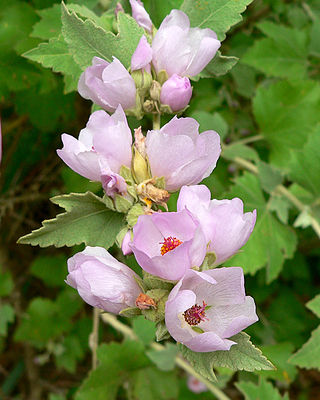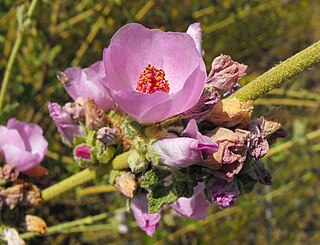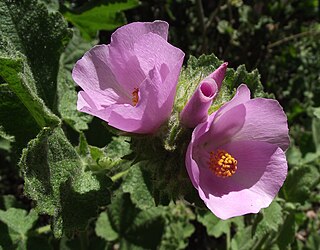
Malvaceae, or the mallows, is a family of flowering plants estimated to contain 244 genera with 4225 known species. Well-known members of economic importance include okra, cotton, cacao, and durian. There are also some genera containing familiar ornamentals, such as Alcea (hollyhock), Malva (mallow), and Tilia. The genera with the largest numbers of species include Hibiscus, Pavonia, Sida, Ayenia, Dombeya, and Sterculia.

Malacothamnus (bushmallow) is a genus of shrubs found throughout much of mainland California and on three of the Channel Islands. Outside of California, Malacothamnus is known from the northern half of Baja California and from a few disjunct locations in Arizona. Plants of this genus are most commonly found in early-successional, post-burn plant communities. Malacothamnus are currently thought to be most closely related to the Iliamnas of the US interior and the Phymosias of Mexico, Central America, and the Caribbean.

Malacothamnus davidsonii is a species of flowering plant in the mallow family known by the common names Tujunga bushmallow and Davidson's bushmallow. It is endemic to Los Angeles County, California, where it primary occurs in and near Big Tujunga Canyon, Little Tujunga Canyon, and Tujunga Wash. The common name Tujunga bushmallow alludes to its geographic distribution. Plants of what has historically been considered Malacothamnus davidsonii from Monterey and San Luis Obispo counties in California were described as the new species Malacothamnus discombobulatus in 2023 based on phylogenetic, morphological, and geographic evidence.
Malacothamnus densiflorus is a species of flowering plant in the mallow family, which has two varieties. It is endemic to the Peninsular Ranges of southwestern California and northwestern Baja California.

Malacothamnus fasciculatus is a species of flowering plant in the mallow family, which has four varieties. It is endemic to southwestern California and northwestern Baja California.
Malacothamnus palmeri is a species of flowering plant in the mallow family known by the common names Cambria bushmallow and Palmer's bushmallow. It is endemic to San Luis Obispo County, California, where it is known from the Santa Lucia Mountains.
Malacothamnus enigmaticus is a species of flowering plant in the mallow family known by the common name enigmatic bush-mallow. It is endemic to the Peninsular Ranges of California and Baja California, Mexico extending from the San Ysidro Mountains in the north to the Sierra de San Pedro Mártir in the south. It was first collected in 1938 and described as a new species to science in 2019. Prior to 2019, it had been mistakenly assigned to Malacothamnus aboriginum and Malacothamnus densiflorus.

Malacothamnus lucianus is a species of flowering plant in the mallow family known by the common names Santa Lucia bushmallow and Arroyo Seco bushmallow and by the cultivar name Hanging Valley bushmallow. It is endemic to Monterey County, California, where it is known from the Santa Lucia Mountains.
Malacothamnus involucratus is a species of flowering plant in the mallow family known by the common name Carmel Valley bushmallow. It is likely endemic to Monterey County, California, where it is known from Carmel Valley and the Jolon region. A single specimen is attributed to San Luis Obispo County, California but the origin of this specimen is questionable.

Mollia is a genus of flowering plants belonging to the family Malvaceae. It is within the Grewioideae subfamily, and the Grewieae tribe.
Malacothamnus mendocinensis is a species of flowering plant in the mallow family known by the common name Mendocino bushmallow. It is endemic to Mendocino County, California, where it is known from only two populations. It was presumed extinct until rediscovered in 2016 and now has a California Rare Plant Rank of 1B.1. In some treatments, Malacothamnus mendocinensis has been included within Malacothamnus fasciculatus or Malacothamnus hallii. Phylogenetic and morphological evidence, however, indicate that it is not closely related to these species and should be recognized as a separate species.
Malacothamnus arcuatus is a species of flowering plant in the mallow family known by the common name arcuate bushmallow. It is endemic to the San Francisco Peninsula, where it is a rare species. It has a California Rare Plant Rank of 1B.2. Malacothamnus arcuatus is occasionally treated within Malacothamnus fasciculatus.
Malacothamnus parishii is a species of flowering plant in the mallow family known by the common name Parish's bushmallow. It is endemic to San Bernardino County, California, where it is confirmed from only a single collection from 1895. It has a California Rare Plant Rank of 1A. Malacothamnus parishii is currently treated as an extreme form of Malacothamnus fasciculatus var. laxiflorus. Phylogenetic analyses are needed to confirm whether it should be treated as a separate species or not.
Malacothamnus hallii is a species of flowering plant in the mallow family known by the common name Hall's bushmallow. It is endemic to southeastern counties of the San Francisco Bay Area, where it is a rare species. It has a California Rare Plant Rank of 1B.2. Malacothamnus hallii is occasionally treated within Malacothamnus fasciculatus.
Malacothamnus orbiculatus is a species of flowering plant in the mallow family known by the common names Tehachapi bushmallow and round-leaved bushmallow. It occurs in California, where it is common after burns on the desert-facing slopes of mountains, and Arizona, where it is currently only known from a few locations. Malacothamnus orbiculatus is occasionally treated within Malacothamnus fremontii but morphological, phylogenetic, and geographic evidence shows them to be distinct species, though there is a small zone of intergradation where their geographic ranges meet.
Malacothamnus astrotentaculatus is a species of flowering plant in the mallow family known by the common name starry-tentacled bushmallow. It is named after the somewhat tentacle-like outgrowths on the calyx that are covered in stellate trichomes. It is endemic to Shasta and Tehama counties in California.
Malacothamnus eastwoodiae is a species of flowering plant in the mallow family known by the common name Alice's lovely bushmallow. It is named after the botanist Alice Eastwood. It is endemic to Santa Barbara County, California and currently only known from Vandenberg Space Force Base.
Malacothamnus discombobulatus is a species of flowering plant in the mallow family known by the common name discombobulating bushmallow. It is morphologically similar to Malacothamnus davidsonii and was treated within M. davidsonii in the past. Malacothamnus discombobulatus is named after the confusion sown from its morphological similarity to M. davidsonii. It is endemic to Monterey and San Luis Obispo counties in California.
Malacothamnus marrubioides is a species of flowering plant in the mallow family known by the common name Santa Clarita bushmallow. It is currently only known from Los Angeles and Ventura counties in California, though its purported type locality suggests it may have occurred further north under or near what is now Millerton Lake.
Malacothamnus foliosus is a species of flowering plant in the mallow family known by the common names Ensenada bushmallow and monarch bushmallow. It is endemic to Baja California, Mexico and has been introduced into Los Angeles County, California. Morphological and geographic evidence indicates that M. foliosus could possibly be treated as multiple taxa, but phylogenetic analyses are inconclusive and more research is needed.






